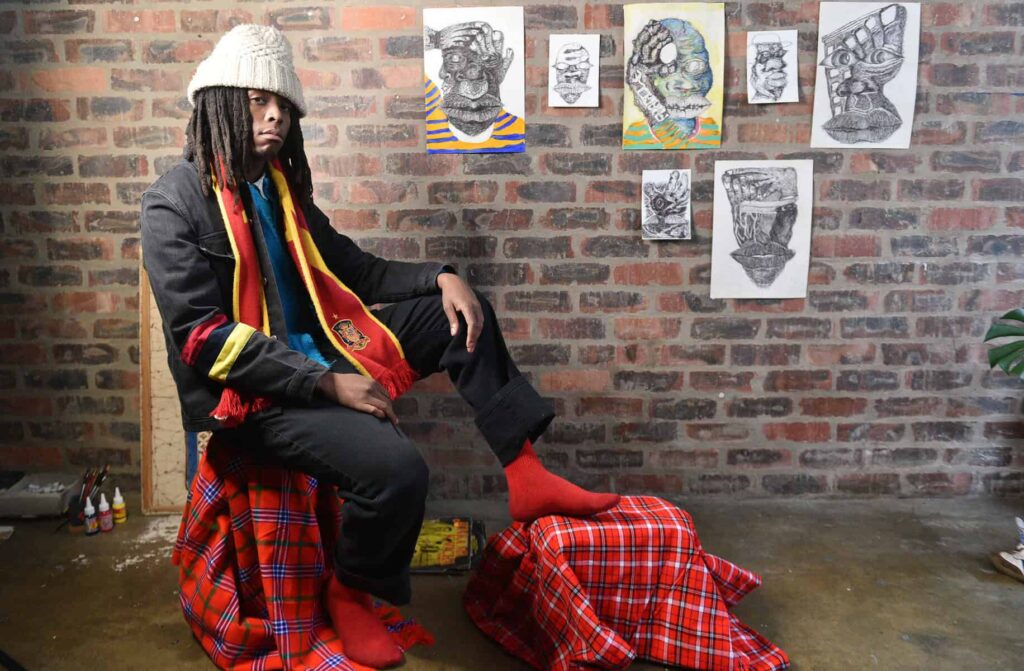Dressed in black with a local flair, Siphesihle Melatho (aka John Johannesburg) blends style with mental health advocacy.
Dressed in a seemingly ordinary pair of jeans and a black jacket, there is more to this man than meets the eye.
His jacket is by local brand Tshepo Jeans, his vintage shoes are army green, and he has a red and yellow scarf wrapped loosely around his neck.
Multidisciplinary artist Siphesihle Melatho, better known as John Johannesburg, dresses up himself and others as thrift store owners and makes them look stylish.
Also read: Creative masterpieces: Standard Bank Young Artists at National Arts Festival [VIDEO]
But he now spends much of his time working on a series of studies about mental health in poor communities.
Music that suits his jams
This artist walks around with an air of having music playing in his head, so it's no surprise that he's a record collector and describes himself as a “vibe dealer – someone who brings vibes to wherever he plays.”
His song selections “go back to the African diaspora, to the '90s and even the '70s,” he said. Some of his musical inspirations include Fela Kuti, the politically active Nigerian jazz artist and Pan-Africanist, and trumpeter Hugh Masekela, the “father of South African jazz,” known for his anti-apartheid songs.
“I was always a different person because of the environment I grew up in. [on the East Rand].
“I've always had long hair. I was interested in fashion and music from a young age, which were forms of self-expression and art in themselves,” Melat said.
He styles his dreadlocks with the same pride he takes in his portraits, which spark conversations about mental health in areas where access to care is limited.
“What does it mean to be poor and have mental problems? What about anxiety, bipolar disorder, multiple personality disorder, stress?” he asks.
These barriers are compounded by economic factors such as poverty, making it difficult for people to access assistance, he says.
Also read: African Art and the White Cube: FEDE's Lebo Kekana talks curating RMB Latitudes Art Fair
“I preach Black consciousness, which is based on a philosophy of self-understanding, and that's why it's important to confront what mental health looks like in order to understand yourself.”
“Also, incorrect diagnoses, often self-diagnoses, can prevent people from moving forward, so having a conversation about what it is can be helpful,” he says.
Melato said the portraits are done with pen because it's a permanent medium.
“Using a pen gives me a lot of anxiety because I can't erase it, so it was a challenge for me to try not to be scared.”
Entering his home studio, wisps of smoke billowing from the high ceilings greet you. The studio in Maboneng is always bustling with movers and shakers, creatives, tourists and traders struggling to survive in the Golden City.
They are similar to Melat, who said he worked hard to pull himself out of poverty: “I'm doing all the promises I made to myself as a child. I have to be the best person ever. I have to be a master in each field, not just a jack of all trades.”
This means constantly honing his craft.Melath's studio is a typical loft, with brick walls and large windows that open onto city views.
An environment that fosters creativity
He lives in an open-plan space, with a staircase leading up to his bedroom, which is fitted out with a futon without a base, and there's artwork here and there, some of which is from abroad.
His work is difficult to miss, as its thematic presence is arresting: it is drawn with pen, using thick black lines and visible repeated strokes to create form.
“I'm just doing art to get back to the heart of what it means to be black and to come from an impoverished community,” Melato says.
He adds that travelling and living in different cities has changed his life: “If I hadn't travelled, I probably would have just been a designer and wouldn't have done what I do now.”
“Living in different cities has opened my eyes to bigger things.” Melato's contribution to subculture is her very existence.
It simply means living life as a black man and as an artist in the world, he says.

